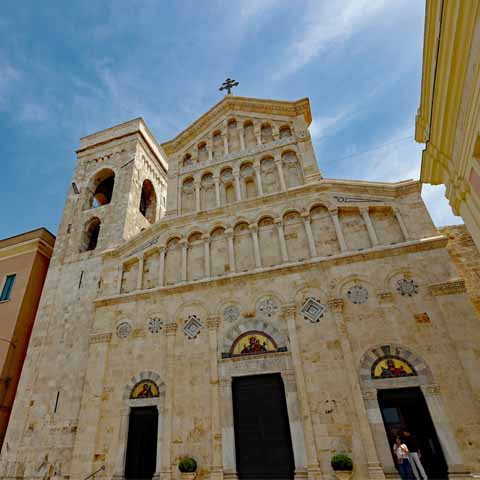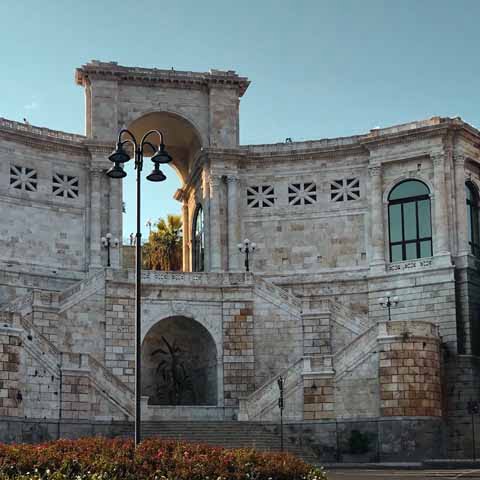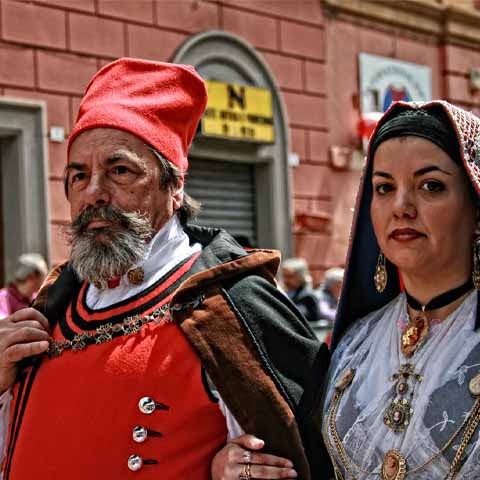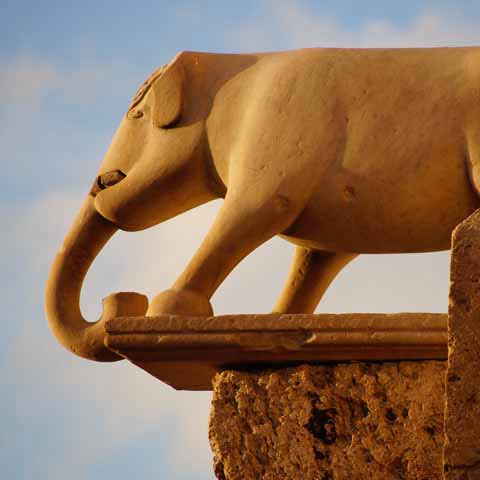Cagliari is a marvelous city with an exciting past. It is the capital of Sardinia, one of the most larger-than-life regions in Italy.
The city has thousands of years of history; it is the administrative center of the island since it was known under the name Caralis, the capital of the Roman province Sardinia et Corsica. Then, it became the capital of the Kingdom of Sardinia. Its name would roughly translate to “rocky settlement” and has its roots in the ancient Mediterranean languages.
Cagliari was known as Krly by the Phoenician and Punic civilizations, while the Latin turned its name into Caralis.
According to the historical-linguistic interpretation, the name is also linked to the existence of two distinct communities that settled in the territory. It is believed the oldest settlement had Punic origins; then, the territory was occupied by Roman immigrants who merged with the locals. Regardless of the origin of the name, it is certain that Cagliari’s history is rich and intricate, spanning over millennia.
PREHISTORY OF CAGLIARI
According to the Roman legends, Caralis was founded by Aristaeus, a Greek god and son of Apollo. It is narrated that he arrived in Sardinia in the fifteenth century BC, introducing the arts of hunting and agriculture to the indigenous people. The same legend also suggests the typical Sardinian dwellings, the Nuraghi, were born in the same period.
Legends apart, the first traces of human civilization in Sardinia date from the fourth millennium BC. The remains of huts discovered in the San Bartolomeo area confirm that the territory of Cagliari was inhabited since the Neolithic period.
Sardinia was a fertile land that guaranteed sustenance to the prehistoric people through fishing, breeding, and agriculture. Some remains from the Copper Age show traces of the Monte Claro culture, which was widespread throughout the island.
Archaeological finds from the Bronze Age, such as the Aegean ceramics, hypothesize that the nuragic populations settled in the territory thanks to the intense commercial and cultural relations with the Mycenaeans.
Historians believe the myth of Aristaeus is nothing but a consequence of the distant memories people from the following epochs had about these ancient interactions between the local people and the Greeks.
The Phoenicians arrived in Sardinia in the eighth century BC and remained there until the fifth century BC when the Carthaginians managed to conquer the territory. Under the new rulers, the settlement experienced rapid growth, as is suggested by the necropolis of Tuvixeddu, the largest Punic necropolis in the Mediterranean. Cagliari became the main center of the island under Carthage and maintained its central administrative role under the Romans, who conquered Sardinia and Corsica in 238 BC. However, it was only granted the status of municipium by Caesar, in 46 BC.
Following Caesar’s death and the beginning of the Imperial age, Cagliari witnessed a period of intense development. During this time, the city received its Roman amphitheater and suburban villas.
During the fall of the Roman Empire, it was conquered by the Vandals, then became the capital of an independent Sardinian kingdom for a short period. Nevertheless, the Romans restored their power in the region in 534 AD, and Cagliari, together with the rest of the island, entered the Byzantine administrative system as the seat of the imperial official of the exarchate of Africa.
HISTORY OF CAGLIARI
During the Gothic war, the contingents of the Goths occupied the city for a short period. Then, Cagliari returned under Byzantine domination.
Due to its exposed position though, it became subject to the Saracen raids first, then from the eleventh century, it entered in conflicts with Pisa and Genoa. Sardinia and consequently Cagliari reached an armistice with these powers in 1215, and Pisa contributed to the erection of Castel di Castro.
However, with the rise of Guglielmo III of Salusio, things started to decline. He decided to sell the Castel to Genoa, a decision that drove the rage of Pisa and the Sardinians. What followed was a year of war that ruined Cagliari, dismembering it in three parts administered by three families, the Arborea in the north, Gallura in the east, and Gherardesca in the west. At the same time, Pisa regained control over the government of Castel di Castro, which was considered the gateway to the Mediterranean.
From this point on, Cagliari would be identified with Castel di Castro, as the current Sardinian name of the city, Casteddu, still shows.
But the city only remained under Pisa for a few decades, until the rise of the Aragonese who, in the war of conquest of Sardinia, besieged Cagliari and laid the basis of the town of Bonaria. However, despite their victory in 1326, the Aragonese did not destroy Cagliari.
On the contrary, after their victory in the battle of Lucocisterna, they left the feudal castle to Pisa. The Aragonese focused more on the economic development of Bonaria, establishing a flourishing port which soon began to threaten Pisa and Tuscany.
It is easy to understand why the Tuscans could not sit back and watch Bonaria grow, so they engaged in a new battle against the Aragonese. The naval battle took place in the Gulf of the Angels in December 1325 and concluded with the victory of the Aragonese.
Pisa was forced to abandon the Castle this time, and the dwellings were given to those who proved their loyalty towards the Aragonese, mainly to the Catalans who moved there from Bonaria.
Under the new Iberian domination, Cagliari became a non-subjugated royal city and seat of the viceroy and was given a municipal code inspired by the code of Barcelona. Soon, the municipality was granted the statute of the capital of the new Kingdom of Sardinia.
However, all residents except for the Catalan-Aragon were forbidden from the Castle area for security reasons, a ban that lasted until the sixteenth century. At the same time, the new rulers focused on expanding the port area, while many Iberian families settled in the region.
But the period of tranquility did not last long. The kingdom first faced the Doria and then the Arborea who, from 1353, unleashed their rage against the Aragonese. The royal territory was reduced to the cities of Cagliari and Alghero, while the remaining part of the territory controlled by the Arborea became the only independent state island entity.
The situation continued to alternate phases in the following decades until 1409, when a military expedition of the Aragonese led by Martino I of Sicily defeated the Arborea in the battle of Sanluri. As such, from 1420, the Kingdom of Sardinia extended its territory to the entire island.
With the marriage of Ferdinand II of Aragon and Isabella I of Castile in 1469, the houses of Castile and Aragon merged their crowns and established distinct institutions in Sardinia.
In 1535, Charles V launched a large naval expedition to Tunis passing by Cagliari. During the same century, the Aragonese strengthened the fortifications and built new ramparts, while the right to live in the Castel area was extended to all citizens. Despite being one of the smallest centers of the Spanish empire compared to Barcelona and Madrid, Cagliari was one of the liveliest.
The city enjoyed an intense intellectual life, and in the seventeenth century, it received its University. But all this intellectual movement did not bring the expected results to the Spaniards. Despite the long history of Spanish domination in the region, the inhabitants of Cagliari started to feel oppressed under the Iberians.
The feeling culminated with the murder of the viceroy in 1668, and a few decades later, during the Spanish succession war at the beginning of the eighteenth century, Cagliari fell under the Anglo-Dutch siege, an event that put an end to the Spanish age in Sardinia.
Following the treaty of Utrecht that divided the territories of the Spanish empire to the other European states, the Kingdom of
Sardinia was assigned first to Austria in 1713 and subsequently, after the ephemeral occupation of Cardinal Giulio Alberoni, it passed under Savoy domination on August 8, 1720, as a result of the Treaty of Hague.
During the reforms that involved all of Europe, Cagliari knew a relative period of prosperity characterized by the growth of the university and the establishment of the hospital, state archives, the university library, the School of Surgery, and the Royal Printing House. However, the city, which was now administered by Piedmont, was refused the request for greater autonomy. As a result, the locals rose against Piedmont, but the revolt was engulfed by an anti-feudal uprising in the rest of the island and had no consequences.
Between the end of the eighteenth century and beginning of the nineteenth, Cagliari, now reoccupied, became the political and administrative center of the Kingdom of Sardinia and home of the Savoy court.
The presence of the court in the city did not prevent the emergence of various conspiracies against their rule, though.
At the same time, the city knew a strong development. In 1811, the streets of the city got their first public lighting, while the road network was restored. But after a brief period of prosperity, Cagliari entered a period of famine followed by a fever epidemic in 1816.
Towards the middle of the century, Cagliari became the center of a new popular movement led by King Charles Albert in an attempt to recognize the fusion of the island with the mainland states, especially Piedmont and Liguria.
Despite these events, the first half of the nineteenth century can be defined as the golden age of the Sardinian culture. During these decades, Cagliari knew a true decline of the feudal aristocracy in favor of a cultural aristocracy which, with the abolition of feudalism and the granting of the Albertine Statute, became the ruling class.
After the Unification of Italy, the city walls were demolished, and the foundations were laid for the great urban expansion of the last century. In fact, many entrepreneurs attracted by the many unexpressed potentialities of the island, settled down in Cagliari, favoring the modernization of the city through the first forms of industrialization.
This is how the transition from an Ancient Regime to a capitalist society took place. Sardinian architects redesigned the urban center according to the tastes of the time. During the era, Cagliari received many of its neoclassical and neo-gothic buildings, but also numerous liberty style edifices. The center of power also moved from the old Castel quarter to the modern area of the port, a place of trade and commerce.
But all this modernization also led to a rise in living costs, which concluded with strikes and several deaths.
Interested in the modernization of the area, the Mussolini government allocated more than one billion Italian lire for the development of Sardinia, which would largely go to Cagliari. However, the Fascist movement arrived violently in the city, leading to the occupation of many seats of adverse parties and death of opponents.
At the end of the 1920s, with the annexation of other surrounding municipalities, Cagliari reached 100,000 inhabitants. Trying to address the new demands, a young municipal designer was responsible for creating important public works. Some of these include the public gardens as well as a few parks.
During World War II, the city suffered numerous bombings that affected almost all areas. In 1948, it officially became the capital of Sardinia in accordance with the Statute of the Autonomous Region of Sardinia. From then on, the city entered into a phase of development and doubled its population.
During the last half of the twentieth century, the urban center extended towards the coast, giving rise to the districts of San Benedetto, La Vega, San Michele, Bonaria, and Tucumannu.
ARCHAEOLOGY IN CAGLIARI
Cagliari boasts interesting open-air archaeological itineraries as well as the most interesting archaeological museum in Sardinia.
The outdoor sites belong to various eras; perhaps the most suggestive is the necropolis of Tuvixeddu. In the San Bartolomeo area, there are also remains of characteristic prehistoric huts visible. Scattered throughout the area surrounding Cagliari, there are also many Nuraghi, conical dwellings made of stone blocks reminiscent of both the Scottish broches and the Trulli of Alberobello.
The National Archaeological Museum of Cagliari holds many of the vestiges found both in the urban area and in other parts of Sardinia. The collections include important artifacts from the pre-roman and Roman eras, as well as important vestiges from the Middle Ages.
Don't just see Italy, live it.
Your dream trip to Italy has never been closer
No more endlessly scrolling travel sites. Our travel experts will craft the perfect, one-of-a-kind trip just for you.

300+
DESTINATIONS
We offer more Italian destinations than any travel site. Do and see more with Trips 2 Italy.
1 (of a kind)
ITINERARIES
Because your dream trip to Italy should be designed for you, not for the masses.
100%
PEACE OF MIND
From flights and accommodations, to food and activities - we take care of every detail.






